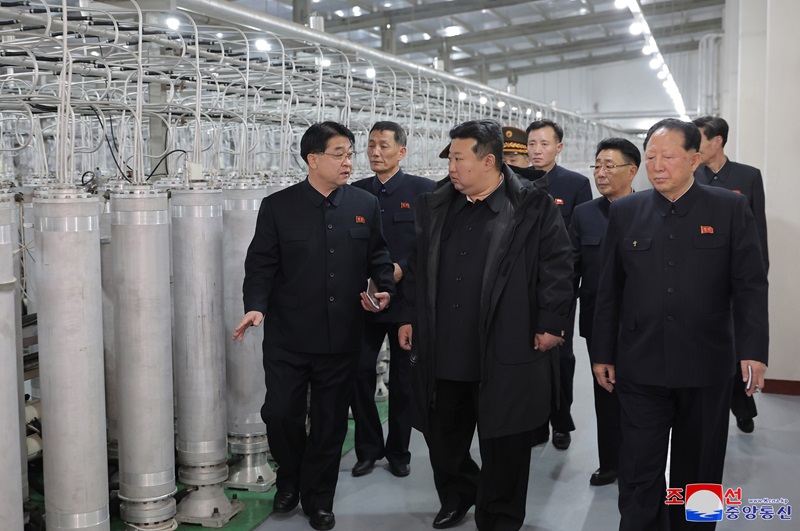The South Korean government has assessed that the highly enriched uranium (HEU) production facility that North Korea publicly revealed on January 29 is located at the Yongbyon nuclear complex in North Pyongan Province, according to government sources.
North Korean state media previously released multiple photographs of Kim Jong-un inspecting a “nuclear material production base” and a “nuclear weapons research institute,” but did not disclose the location or timing of the visit.
The exposure of two HEU facilities in just four months—one in September before the U.S. presidential election and another on January 29 following Trump’s inauguration—suggests Pyongyang is escalating its nuclear pressure on Washington.

nkphoto@yna.co.kr/2025-01-29 06:45:19/
According to the newspaper the official stated, “We are conducting a detailed analysis, but the early assessment suggests this facility is not in Kangson, but rather in Yongbyon.”
The interior layout of the facility, densely packed with centrifuges for uranium enrichment, closely resembles the nuclear site North Korea revealed in September. However, government analysts noted signs of aging infrastructure, supporting the assessment that it is an older facility rather than an undisclosed third nuclear site.
Another government source confirmed that the facility is not believed to be a previously unknown third nuclear site.
South Korea had previously assessed that the HEU facility North Korea revealed in September was located in Kangson.
North Korea’s decision to reveal two HEU production facilities within just four months is seen as an attempt to increase its leverage in potential U.S.-North Korea negotiations on nuclear freeze and arms control.
Unlike plutonium production, which requires large-scale reactors and reprocessing facilities that can be easily detected by U.S. and South Korean reconnaissance assets, HEU production facilities can be built underground and are much harder to detect due to their smaller scale.
According to South Korean intelligence estimates, North Korea operates between 10,000 and 12,000 centrifuges at Yongbyon and Kangson combined, allowing it to produce 200 to 240 kilograms of HEU annually.
“This amount of HEU could be used to build up to 10 nuclear warheads per year,” an official said.
Recent intelligence suggests that North Korea has been accelerating uranium enrichment activities at both Yongbyon and Kangson.
In addition to HEU production, North Korea is continuing plutonium production at Yongbyon.
The 5MW reactor and the experimental light water reactor (ELWR) at Yongbyon remain operational. If fully utilized, these reactors could produce up to 26 kilograms of plutonium per year, enough for up to seven nuclear warheads.
South Korean officials assess that North Korea has maintained the Yongbyon reactor in an operable state since resuming its operation in 2021 to enable the extraction and reprocessing of spent nuclear fuel at any time.
“If the spent fuel rods produced by the reactor are reprocessed at Yongbyon’s Radiochemical Laboratory, North Korea can extract additional plutonium,” a government source explained.
The latest revelations reinforce concerns that North Korea is systematically expanding both its HEU and plutonium production capabilities, further escalating its nuclear capabilities amid growing tensions with the Trump administration.
BY YOUNGNAM KIM [kim.youngnam@koreadaily.com]




